 |
| Keystone Press/Alamy |
This week’s series on royal-royal state visits from generations past wraps up today with a look at an exceptionally sparkly British state visit to Stockholm in June 1956. This one’s got it all: banquets, galas, balls, and even the Olympics!
 |
| Queen Elizabeth II reviews a guard of honor during a tour of Nigeria, February 1956 (Fox Photos/Hulton Archive/Getty Images) |
In June 1956, Queen Elizabeth II of the United Kingdom had just turned thirty. She and the Duke of Edinburgh, who celebrated his 35th birthday during their trip to Sweden, had been married for eight years, and she’d been on the throne for half that time. They had two children: Prince Charles (7) and Princess Anne (5). The young queen was on the verge of a challenging year. Late 1956 would bring rumors of a personal crisis, as whispers about the Duke of Edinburgh’s behavior, and his lengthy world tour that autumn, led the palace to issue a strongly worded denial of any trouble in the marriage. More serious yet was the political crisis on the horizon. In 1956, Britain joined France and Israel in military actions over the Suez Canal, and the fallout from these decisions led to the resignation of Prime Minister Anthony Eden and damage to international relationships.
 |
| King Gustaf VI Adolf of Sweden at the Opening of Parliament with Princess Sibylla, Princess Margaretha, and Princess Birgitta, January 1956 (Anefo/Nationaal Archief/Wikimedia Commons) |
In Sweden, 73-year-old King Gustaf VI Adolf and 66-year-old Queen Louise had been on the throne since 1950. Though King Gustaf Adolf and his first wife, Princess Margaret of Connaught, had had five children before her unexpected death, the core of the Swedish royal family was rather small. King Gustaf Adolf’s heir, Prince Gustaf Adolf, had died in a plane crash in Denmark in 1947. His widow, 48-year-old Princess Sibylla, and their five children (Princess Margaretha [21], Princess Birgitta [19], Princess Desiree [18], Princess Christina [12], and Prince Carl Gustaf [10]) often supported the king and queen at royal events. The king’s daughter, Ingrid, was married to King Frederik IX of Denmark; two more sons, Sigvard and Carl Johan, had lost their titles when they married commoners. The king’s third son, 44-year-old Prince Bertil, had not married his longtime companion, Lilian Craig, to maintain his royal role, in part so that he could act as a regent for the young Prince Carl Gustaf if needed.

The Queen and the Duke of Edinburgh left for the state visit on Monday, June 4, boarding the royal yacht Britannia from the North Yorkshire port of Teesport. The Queen wore the Flower Basket Brooch for their official departure, which was preceded by a slate of engagements in the area.
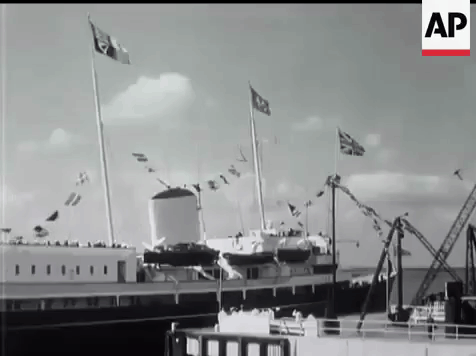
The royals often used Britannia for foreign travel during this era, usually without incident. This trip, however, proved to be unexpectedly challenging. Britannia was scheduled to deliver the Queen to Sweden on Friday, June 8. That morning, a dense fog developed over Stockholm’s archipelago as Britannia and her escorts — two Swedish destroyers, two British destroyers, several British torpedo boats, and a Canadian frigate — sailed toward the capital. The Guardian reported that the ships “groped their way by radar, with local pilots on board, up the mist-shrouded Stockholm Archipelago at intervals of several miles from each other instead of the intended close formation, and sometimes barely at five knots. The archipelago’s alleged 24,000 islands…fitfully appeared and vanished as what the Stockholmers call a “London fog” cleared or condensed.”
 |
| Wikimedia Commons |
Thankfully, the fog lifted, allowing Britannia to arrive in Stockholm only an hour behind schedule. The Queen and the Duke were rowed to shore on the Swedish royal barge, escorted by Prince Bertil, and were greeted by King Gustaf Adolf and Queen Louise at the dock.
The Queen wore a white dress with red accents and white accessories for her arrival. One of Queen Victoria’s Diamond Bow Brooches was pinned to her frock. The rest of the Swedish royal family had gathered to greet their British cousins. (Both the late Princess Margaret of Connaught and Queen Louise were cousins of Queen Elizabeth; Queen Louise was also Prince Philip’s aunt.) The press especially remarked on the poise and seriousness of the ten-year-old heir to the throne, Prince Carl Gustaf.
 |
| Pål-Nils Nilsson/Swedish National Heritage Board/Wikimedia Commons |
The royals rode through the streets of Stockholm to the Royal Palace, greeted by enthusiastic but quiet crowds all along the way. The Guardian noted that “Stockholmers today showed their pleasure with flag-waving and smiles and the mere fact that they were all there in their finery.” Newsreel footage from the arrival, though, provides background noise full of cheers.
At the palace, the Queen and the Duke received heads of diplomatic missions ahead of an evening reception that featured a 600-member choir serenading the royals.

People gathered in front of the palace to listen to the music and to cheer the royals, who made a special balcony appearance.

And then, it was time for the grand state banquet. With her evening gown and the Order of the Seraphim, the Queen wore the Vladimir Tiara with its emerald drops and the Delhi Durbar Necklace and Earrings. During the banquet, King Gustaf Adolf paid a special tribute to his guests, noting, “No guests could be more welcome in our country than the Queen of England and her Consort.” In her speech, the Queen replied, “My husband and I have long looked forward to visiting your Majesty in Sweden, and are happy to be in your capital, at once ancient and modern, whose famous buildings are worthy of the beauty of their setting.”
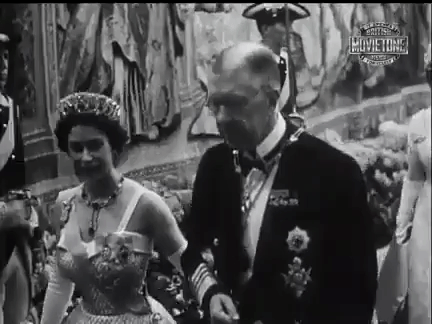
Queen Louise also broke out the big jewels for the occasion, wearing the enormous Braganza Tiara for the state banquet. She’s also wearing two diamond necklaces, the family’s large oval diamond brooch, and diamond earrings (either the Karl Johan Earrings or the Vasa Earrings).

Several other members of the Swedish royal family were also present, some in tiaras. Above, Princess Desiree wears the Swedish Aquamarine Bandeau as she is escorted in to the banquet by Lord Mountbatten. Behind her, Princess Birgitta doesn’t appear to be wearing a tiara. But two other royal ladies definitely did: Princess Sibylla appears to have worn the Swedish Aquamarine Kokoshnik, and Princess Margaretha wore Queen Louise’s Diamond Tiara.
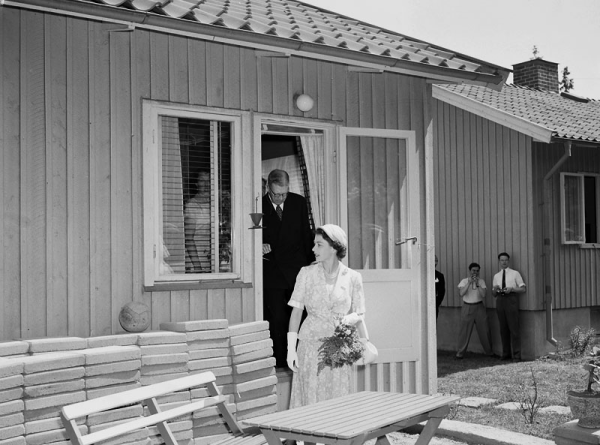 |
| Jan Ehnemark/Wikimedia Commons |
The second day of the visit (Saturday, June 9, 1956) included the dispatch of a telegram of sympathy. The Queen sent a message of support to President Eisenhower, who had undergone major intestinal surgery in the United States. The slate of engagements back in Stockholm was full, including a visit to a Swedish home in Angby that had been built with the help of government assistance funds.

The Queen also toured a nursery with King Gustaf Adolf, and both of them appeared to enjoy visiting with Swedish babies.

They also went to the Museum of National Antiquities, where King Gustaf Adolf presented Queen Elizabeth with an 18th-century Swedish naval sword, a gift from the royal Swedish navy. Tradition in England states that anyone who receives a sharp object as a gift must pay the giver with a coin, or the gift will “sever” their friendship. Accordingly, the Queen tucked a copper coin into the King’s hand as he presented her with the sword.
The royals traveled aboard the Swedish royal barge to Stockholm’s city hall, where they attended a grand luncheon offered by the city of Stockholm for their royal guests. On the way, the press were amused that the boat passed by a building with nude sunbathers on the roof. The men and women reportedly leapt to their feet and cheered the Queen. One article — with the headline “Hats, and Everything, Off to the Queen!” — noted that the sunbathers “got no apparent acknowledgement from the royal visitors, but plenty of attention from the crowd.”

Cameras captured the Queen laughing and chatting with Prince Bertil during the luncheon. Because the press did not know about Bertil’s long-term relationship with Lilian Craig, he was often discussed as a possible marriage option for various European princesses. During this visit, the press linked his name with Princess Margaret — even though he was almost two decades her senior.

In the afternoon, the Queen and the Duke attended a reception for British residents of Stockholm. The Queen wore the Cambridge Emerald Cluster Brooch for the occasion.

That evening, the royals donned their tiaras once more for a second gala event: a performance at the Royal Opera House. The camera didn’t get very close to the royal box, so you’ll just have to trust me on these jewelry identifications! The Queen wore Queen Alexandra’s Kokoshnik for the gala, as well as the Greville Ruby Necklace and Queen Mary’s Ruby Cluster Earrings. Queen Louise of Sweden paired Queen Sofia’s Tiara with the Napoleonic Amethyst Necklace and a brooch from the same suite. Princess Sibylla wore the Connaught Diamond Tiara with her sapphire necklace, and Princess Margaretha again wore Queen Louise’s Diamond Tiara. The Queen gave the crowd at the performance a good laugh when she accidentally dropped her bouquet of red roses over the edge of the royal box and into the orchestra pit. The Sydney Morning Herald wrote that she “smiled, and then broke into laughter.” Soon the entire royal box was in hysterics, and the crowd below began to applaud the Queen’s blunder.
The Duke of Edinburgh celebrated his 35th birthday on the third day of the state visit (Sunday, June 10, 1956). He and the Queen began the day by chatting on the telephone over breakfast with Prince Charles and Princess Anne, who wished their father a happy birthday. Next, they attended services at the English church in Stockholm. Prayers were said for President Eisenhower during the service.
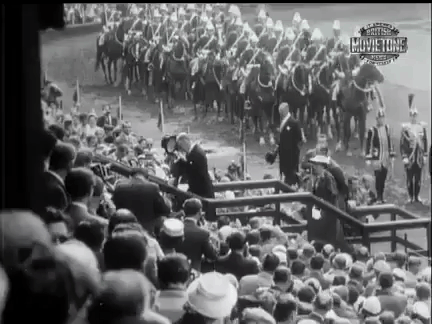
And then, everyone got in their carriages and went to the Olympics! I can hear you already, reminding me that the 1956 Summer Olympic Games were held in Melbourne, and you’re almost 100% correct. Most of the competitions were held in Australia later that year, but because of strict six-month quarantine rules for horses entering that country, the equestrian events for the Games were held in Stockholm in June 1956 instead. The show jumping, dressage, and eventing competitions were all held in the stadium in Stockholm that had been built for the 1912 Olympic Games.

The Queen rode beside King Gustaf Adolf in a carriage as they joined the procession into the stadium. I believe that’s the Williamson Pink Diamond Brooch on her jacket.

The entire opening ceremony of this equestrian mini-Olympics was conducted on horseback — even the lighting of the Olympic torch! Events were held from June 11-17 in Stockholm, and as you might have guessed, the Queen and the Duke stayed on for the duration, spending the week aboard Britannia. Princess Margaret and the Duke and Duchess of Gloucester flew in to attend the Games, too. The royals threw a cocktail party for the equestrian competitors on board the ship that week.
While I won’t dwell on the entire week of equestrian events, I will highlight two more glittering events from the end of the Queen and the Duke’s private visit to Stockholm. With so many visiting royals in town attending the equestrian Olympic events, the Swedish royals rolled out the red carpet with a pair of dazzling galas. The first, held on the night of Thursday, June 14, 1956, was a theatrical evening at Drottningholm Palace, where the royals watched a performance of an eighteenth-century comic opera.

Queen Elizabeth wore the Girls of Great Britain and Ireland Tiara with jewels from the Brazilian Aquamarine Parure for the evening. She secured her sash with the Dorset Bow Brooch, and I believe I spot the Edinburgh Wedding Bracelet on her right wrist.

Queen Louise sparkled in the Baden Fringe Tiara and the Processional Jewels.

Princess Margaret wore the Cartier Halo Tiara with one of her diamond necklaces. The Duchess of Gloucester also wore diamonds, including her Diamond Bandeau.
And in this picture, taken inside the eighteenth-century Drottningholm Palace court theater, you’ll be able to spot even more royals and royal jewels. Along with the jewels already mentioned, you’ll see Hereditary Grand Duchess Josephine-Charlotte of Luxembourg wearing the Belgian Scroll Tiara with her mother’s emerald earrings and her own Emerald Peacock Necklace, as well as Princess Margaretha of Sweden wearing Queen Louise’s Diamond Tiara and Princess Eugenie of Greece and Denmark wearing her diamond tiara.
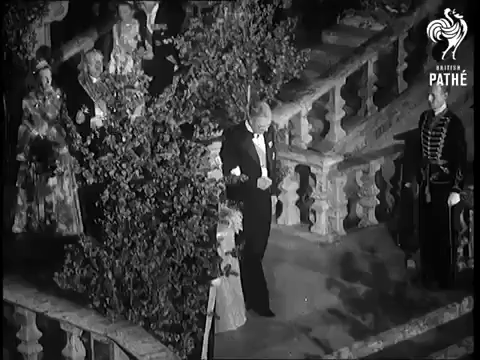
On Friday, June 15, 1956, the royals attended the glittering Order of Amaranth Ball at Stockholm’s City Hall. The venue will be a familiar one for readers of this website, because it’s the place where the annual Nobel Prize banquet is held. Here’s Queen Elizabeth descending that familiar staircase on the arm of King Gustaf Adolf.

The Grand Order of Amaranth was founded in 1760 in Sweden, and was based on an older, discontinued order of chivalry that was begun by Queen Christina in 1653. (The Swedish order has no relation to the similarly-named, Masonic-affiliated organization in the United States.) The Swedish order hosts a grand biannual ball. Numerous royals attended from the British, Swedish, Norwegian, Dutch, and Luxembourgish royal families.
 |
| Keystone Press/Alamy |
The Queen wore the Girls of Great Britain and Ireland Tiara again for the ball, pairing it with the Nizam of Hyderabad Necklace, the Dorset Bow Brooch, and Queen Mary’s Indian Bangle Bracelets. Thrillingly, the press reported that the Queen’s gown for the evening was made of orange silk.

Queen Louise of Sweden wore the Leuchtenberg Sapphires, and the Duchess of Gloucester appears to have worn Queen Mary’s Honeysuckle Tiara.

Princess Margaret, shown here in the background dancing with her uncle, the Duke of Gloucester, chose the Cartier Halo Tiara for the second evening in a row. She wore a white gown for the ball.

And here’s Countess Estelle Bernadotte dancing with Prince Bernhard of the Netherlands during the ball. She’s wearing a diamond tiara now worn by her daughter-in-law, Countess Jill Bernadotte. Bernhard’s presence in Sweden — without his wife — was a major source of public discussion. On the night of the ball, the Associated Press reported, the Dutch premier “emphatically denied rumors that Queen Juliana might abdicate or that the royal couple might get a divorce or separate.” It was the first time that the premier had commented directly on “openly widespread reports that the Queen and Prince Bernhard might split over the reputed influence of Greet Hofmans, 61-year-old faith healer, on the queen.” (We discussed the Hofmans affair a little bit in yesterday’s post.)

The Queen and the Duke were filmed waltzing together during the ball. The dancing went on long past midnight as the band played Latin ballroom selections. One report noted that the Queen “smiled and laughed happily as she danced the samba with Prince Jean of Luxembourg,” and another reported that “Princess Margaret danced the samba and the mambo into the early morning hours.” I don’t know about all of you, but if I had a time machine, an event like this would be one of the destinations on my list!
Leave a Reply